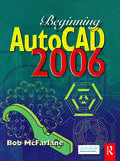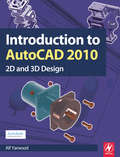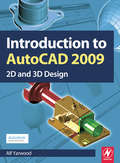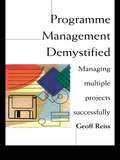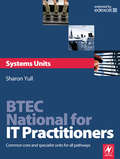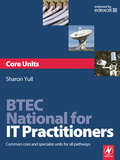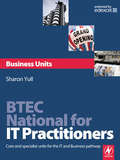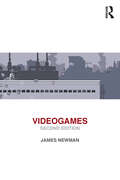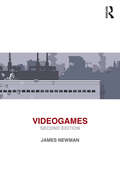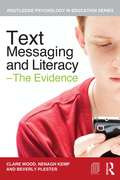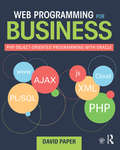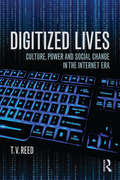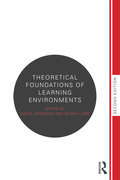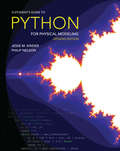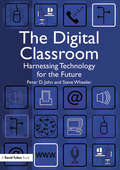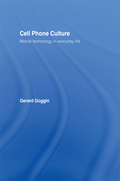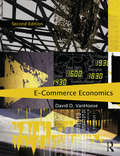- Table View
- List View
Beginning AutoCAD 2006
by Bob McFarlaneBeginning AutoCAD 2006 is a course based on learning and practising the essentials of 2D drawing using AutoCAD. Bob McFarlane’s hands-on approach is uniquely suited to independent learning and use on courses. The focus on 2D drawing in one book ensures the reader gets a thorough grounding in the subject, with a greater depth of coverage than tends to be available from general introductions to AutoCAD. As a result, this book provides a true, step-by-step, detailed exploration of the AutoCAD functions required at each stage of producing a 2D drawing – an approach often not found in the many software reference guides available.The emphasis on learning through doing makes this book ideal for anyone involved in engineering, construction or architecture – where the focus is on productivity and practical skills. The author has also matched the coverage to the requirements of City and Guilds, Edexcel (BTEC) and SQA syllabuses.New features in AutoCAD 2006 are covered in this book including: DYN (dynamic input showing coordinate position and lengths – an important new feature of the latest AutoCAD software), as well as new commands in the Modify and Dimension tool set. The result is a useful refresher course for anyone using AutoCAD at this level, and those upgrading to the new software release. The course is also designed to be fully relevant to anyone using other recent releases, including AutoCAD 2005.
Introduction to AutoCAD 2010
by Alf YarwoodAlf Yarwood provides a practical, structured course of work matched to the latest release of AutoCAD. After introducing first principles and the creation of 2D technical drawings, he goes on to demonstrate the construction of 3D solid drawings, surface model drawings and rendering. All the new features of the 2010 software release are taken into account and the increasing emphasis on 3D solid modelling in the software is reflected in the book. The 2D chapters are also suitable for those learning how to use AutoCAD LT 2010.Suitable for all new users of AutoCAD, this book is particularly applicable to vocational and introductory level undergraduate courses in engineering and construction. Further Education students in the UK will find this an ideal textbook to cater for the City & Guilds 4353 and 2303 qualifications and the relevant CAD units of BTEC National and BTEC Higher National Engineering and Construction schemes from Edexcel. Many Foundation Degrees also contain CAD modules for which this book can be of use.Readers will also be able to visit a free companion website at http://books.elsevier.com/companions/9781856178686, where they will find worked solutions and AutoCAD drawing files of stages and results for the exercises in the book, as well as further exercises and multiple-choice questions with answers.
Introduction to AutoCAD 2010
by Alf YarwoodAlf Yarwood provides a practical, structured course of work matched to the latest release of AutoCAD. After introducing first principles and the creation of 2D technical drawings, he goes on to demonstrate the construction of 3D solid drawings, surface model drawings and rendering. All the new features of the 2010 software release are taken into account and the increasing emphasis on 3D solid modelling in the software is reflected in the book. The 2D chapters are also suitable for those learning how to use AutoCAD LT 2010.Suitable for all new users of AutoCAD, this book is particularly applicable to vocational and introductory level undergraduate courses in engineering and construction. Further Education students in the UK will find this an ideal textbook to cater for the City & Guilds 4353 and 2303 qualifications and the relevant CAD units of BTEC National and BTEC Higher National Engineering and Construction schemes from Edexcel. Many Foundation Degrees also contain CAD modules for which this book can be of use.Readers will also be able to visit a free companion website at http://books.elsevier.com/companions/9781856178686, where they will find worked solutions and AutoCAD drawing files of stages and results for the exercises in the book, as well as further exercises and multiple-choice questions with answers.
Introduction to AutoCAD 2009
by Alf YarwoodAlf Yarwood provides a practical, structured course of work matched to the latest release of AutoCAD. After introducing first principles and the creation of 2D technical drawings, he goes on to demonstrate the construction of 3D solid and surface model drawings and rendering. All the new features of the 2009 software release are taken into account and the increasing emphasis on 3D solid modelling in the software is reflected in the book. The 2D chapters are also suitable for those learning how to use AutoCAD LT 2009.Suitable for all new users of AutoCAD, this book is particularly applicable to vocational and introductory level undergraduate courses in engineering and construction. It is an ideal textbook for the City & Guilds Computer Aided Design and Engineering qualifications (4353 and 2303)and the relevant CAD units of BTEC National and BTEC Higher National Engineering and Construction schemes from Edexcel.A free companion website is available at http://books.elsevier.com/companions/9780750689830 and features: Worked solutions and AutoCAD drawing files of stages and results for the exercises in the bookFurther exercises and multiple-choice questions with answers.
Introduction to AutoCAD 2009
by Alf YarwoodAlf Yarwood provides a practical, structured course of work matched to the latest release of AutoCAD. After introducing first principles and the creation of 2D technical drawings, he goes on to demonstrate the construction of 3D solid and surface model drawings and rendering. All the new features of the 2009 software release are taken into account and the increasing emphasis on 3D solid modelling in the software is reflected in the book. The 2D chapters are also suitable for those learning how to use AutoCAD LT 2009.Suitable for all new users of AutoCAD, this book is particularly applicable to vocational and introductory level undergraduate courses in engineering and construction. It is an ideal textbook for the City & Guilds Computer Aided Design and Engineering qualifications (4353 and 2303)and the relevant CAD units of BTEC National and BTEC Higher National Engineering and Construction schemes from Edexcel.A free companion website is available at http://books.elsevier.com/companions/9780750689830 and features: Worked solutions and AutoCAD drawing files of stages and results for the exercises in the bookFurther exercises and multiple-choice questions with answers.
Portfolio and Programme Management Demystified: Managing Multiple Projects Successfully (PDF)
by Geoff ReissThis book provides the perfect companion to Geoff Reiss's Project Management Demystified and presents the techniques of multi-project management in a lively, approachable manner. It covers budgets, cost control, planning problems and matrix management formulae. Drawing on a wide range of case histories and lively examples, it tackles organisational issues and the multi-project conflicts that often arise.
BTEC National for IT Practitioners: Systems units
by Sharon YullBTEC National for IT Practitioners: Systems Units has been written specifically to cover the systems pathway of the BTEC National specifications.This book caters for one of the most popular pathways in the BTEC National specifications, bringing together all the key specialist units for students who have chosen the systems route, including the core units specific to this pathway that aren't covered in the core unit book. When used alongside its companions for the core units and business pathways, this series delivers the most accessible and usable student textbooks available for the BTEC National.Units covered: Unit 11 – Data Analysis and Design Unit 22 – Network ManagementUnit 13 – Human Computer Interaction Unit 28 – IT Technical SupportUnit 16 – Maintaining Computer Systems Unit 29 – IT Systems Troubleshooting and Repair Written by an experienced tutor, each unit is illustrated with assessment activities, end-of-chapter questions, case studies and practical exercises. The result is a clear, straightforward textbook that encourages independent study and acts as a reference to various topics within the qualification.
BTEC National for IT Practitioners: Systems units
by Sharon YullBTEC National for IT Practitioners: Systems Units has been written specifically to cover the systems pathway of the BTEC National specifications.This book caters for one of the most popular pathways in the BTEC National specifications, bringing together all the key specialist units for students who have chosen the systems route, including the core units specific to this pathway that aren't covered in the core unit book. When used alongside its companions for the core units and business pathways, this series delivers the most accessible and usable student textbooks available for the BTEC National.Units covered: Unit 11 – Data Analysis and Design Unit 22 – Network ManagementUnit 13 – Human Computer Interaction Unit 28 – IT Technical SupportUnit 16 – Maintaining Computer Systems Unit 29 – IT Systems Troubleshooting and Repair Written by an experienced tutor, each unit is illustrated with assessment activities, end-of-chapter questions, case studies and practical exercises. The result is a clear, straightforward textbook that encourages independent study and acts as a reference to various topics within the qualification.
BTEC National for IT Practitioners: Core units
by Sharon YullBTEC National for IT Practitioners has been written specifically to cover the compulsory core units and selected specialist units of the BTEC National specifications. This book provides core unit coverage for students following all courses within the new scheme – National Awards, National Certificates and National Diplomas. When used alongside its companions for the business and systems support pathways, this series delivers the most accessible and usable student textbooks available for the BTEC National.Units covered: Unit 1 – Communication and Employability Skills Unit 8 – Communication TechnologiesUnit 2 – Computer Systems Unit 15 – Organizational Systems SecurityUnit 3 – Information Systems Unit 18 – Principles of Software Design and DevelopmentUnit 7 – IT Systems Analysis and Design Unit 21 – Website Production and Management Written by an experienced tutor, each unit is illustrated with assessment activities, end-of-chapter questions, case studies and practical exercises. The result is a clear, straightforward textbook that encourages independent study and acts as a reference to various topics within the qualification.
BTEC National for IT Practitioners: Core units
by Sharon YullBTEC National for IT Practitioners has been written specifically to cover the compulsory core units and selected specialist units of the BTEC National specifications. This book provides core unit coverage for students following all courses within the new scheme – National Awards, National Certificates and National Diplomas. When used alongside its companions for the business and systems support pathways, this series delivers the most accessible and usable student textbooks available for the BTEC National.Units covered: Unit 1 – Communication and Employability Skills Unit 8 – Communication TechnologiesUnit 2 – Computer Systems Unit 15 – Organizational Systems SecurityUnit 3 – Information Systems Unit 18 – Principles of Software Design and DevelopmentUnit 7 – IT Systems Analysis and Design Unit 21 – Website Production and Management Written by an experienced tutor, each unit is illustrated with assessment activities, end-of-chapter questions, case studies and practical exercises. The result is a clear, straightforward textbook that encourages independent study and acts as a reference to various topics within the qualification.
BTEC National for IT Practitioners: Business units
by Sharon YullBTEC National for IT Practitioners: Business Units has been written specifically to cover the business pathway of the BTEC National specifications. This book caters for one of the most popular pathways in the BTEC National specifications, bringing together all the key specialist units for students who have chosen the business route, including the core units specific to this pathway that aren't covered in the core unit book. When used alongside its companions for the core units and systems support pathways, this series delivers the most accessible and usable student textbooks available for the BTEC National. Units covered: Unit 1 – Exploring Business Activity Unit 4 – IT ProjectUnit 2 – Investigating Business Resources Unit 34 – E CommerceUnit 3 – Introduction to Marketing Unit 35 – Impact of the Use of IT on Business SystemsUnit 4 – IT ProjectUnit 34 – E CommerceUnit 35 – Impact of the Use of IT on Business SystemsWritten by an experienced tutor, each unit is illustrated with assessment activities, end-of-chapter questions, case studies and practical exercises. The result is a clear, straightforward textbook that encourages independent study and acts as a reference to various topics within the qualification.
BTEC National for IT Practitioners: Business units
by Sharon YullBTEC National for IT Practitioners: Business Units has been written specifically to cover the business pathway of the BTEC National specifications. This book caters for one of the most popular pathways in the BTEC National specifications, bringing together all the key specialist units for students who have chosen the business route, including the core units specific to this pathway that aren't covered in the core unit book. When used alongside its companions for the core units and systems support pathways, this series delivers the most accessible and usable student textbooks available for the BTEC National. Units covered: Unit 1 – Exploring Business Activity Unit 4 – IT ProjectUnit 2 – Investigating Business Resources Unit 34 – E CommerceUnit 3 – Introduction to Marketing Unit 35 – Impact of the Use of IT on Business SystemsUnit 4 – IT ProjectUnit 34 – E CommerceUnit 35 – Impact of the Use of IT on Business SystemsWritten by an experienced tutor, each unit is illustrated with assessment activities, end-of-chapter questions, case studies and practical exercises. The result is a clear, straightforward textbook that encourages independent study and acts as a reference to various topics within the qualification.
Videogames
by James NewmanIn the few decades since they first blipped their way onto television screens, videogames have become one of the most culturally, socially and economically significant media forms. Newman’s volume considers how we might approach videogames as media texts to be read, experiences to be played and played with, systems and simulations to be decoded and interrogated, and performances to be captured, codified and preserved. The updated second edition examines the emergence of new platforms as well as changing patterns of production and consumption in its analysis of Wii, Xbox 360, PS3 and mobile gaming. The new final chapter explores recent developments in games scholarship with particular focus falling on the study of gameplay as socially situated, ‘lived experience’, and on strategies for game history, heritage and preservation. In drawing attention to the fragility and ephemerality of hardware, software and gameplay, this new edition encourages readers and players not only to consider how games might be studied but also what can, will and should be left behind for the next generation of games researchers.
Videogames
by James NewmanIn the few decades since they first blipped their way onto television screens, videogames have become one of the most culturally, socially and economically significant media forms. Newman’s volume considers how we might approach videogames as media texts to be read, experiences to be played and played with, systems and simulations to be decoded and interrogated, and performances to be captured, codified and preserved. The updated second edition examines the emergence of new platforms as well as changing patterns of production and consumption in its analysis of Wii, Xbox 360, PS3 and mobile gaming. The new final chapter explores recent developments in games scholarship with particular focus falling on the study of gameplay as socially situated, ‘lived experience’, and on strategies for game history, heritage and preservation. In drawing attention to the fragility and ephemerality of hardware, software and gameplay, this new edition encourages readers and players not only to consider how games might be studied but also what can, will and should be left behind for the next generation of games researchers.
Text Messaging and Literacy – The Evidence
by Clare Wood Nenagh Kemp Beverly Plester"Well thought out and timely. This is the leading group in the world working on texting and literacy, and they have a strong track record of publications. It would also be the first book, as they say, to deal with the subject at an academic level. The focus on education is important, as this is where most of the anxieties lie. It will be a major step forward in creating a new climate." Professor David Crystal, author of The Cambridge Encyclopaedia of Language and The Cambridge Encyclopaedia of the English Language, Television consultant and presenter As children are given mobile phones at increasingly younger ages, there is considerable media coverage of claims that mobile phones, and text messaging in particular, are responsible for declining levels of literacy in children and young people. Such claims are often adopted wholesale by teachers and parents, despite the fact that there is an empirical literature which has failed to find a basis to these claims, and to the contrary has found that text messaging is supporting children’s literacy skills. Written by leading international researchers Text Messaging and Literacy presents an overview and discussion of the academic evidence for and against use of text messaging and mobile phones in supporting literate activity and discusses what conclusions we can and should draw about the impact of mobile phones, and their potential role in education. Areas covered include: the rise of texting and media reactions; children’s reading, spelling and texting; text messaging of children with language difficulties; using mobile phones for literacy development; texting and literacy skills in adolescents and adults; spelling and grammar in texting and beyond; the future of texting. In challenging existing assumptions the authors present the cutting edge of international research, highlighting their own studies involving children of all ages, adolescents and adults. This ground breaking book is essential reading for both researchers and students in education, educational psychology, literacy and new media and it’s impact on learning.
Web Programming for Business: PHP Object-Oriented Programming with Oracle
by David PaperWeb Programming for Business: PHP Object-Oriented Programming with Oracle focuses on fundamental PHP coding, giving students practical, enduring skills to solve data and technical problems in business. Using Oracle as the backend database, the book is version-neutral, teaching students code that will still work even with changes to PHP and Oracle. The code is clean, clearly explained and solutions-oriented, allowing students to understand how technologies such as XML, RSS or AJAX can be leveraged in business applications. The book is fully illustrated with examples, and includes chapters on: Database functionality Security programming Transformation programming to move data Powerpoint slides, applied exam questions, and the raw code for all examples are available on a companion website. This book offers an innovative approach that allows anyone with basic SQL and HTML skills to learn PHP object-oriented programming.
Digitized Lives: Culture, Power, and Social Change in the Internet Era
by T. V. ReedIn a remarkably short period of time the Internet and associated digital communication technologies have deeply changed the way millions of people around the globe live their lives. But what is the nature of that impact? In chapters examining a broad range of issues—including sexuality, politics, education, race, gender relations, the environment, and social protest movements—Digitized Lives seeks answers to these central questions: What is truly new about so-called "new media," and what is just hype? How have our lives been made better or worse by digital communication technologies? In what ways can these devices and practices contribute to a richer cultural landscape and a more sustainable society? Cutting through the vast—and often contradictory—literature on these topics, Reed avoids both techno-hype and techno-pessimism, offering instead succinct, witty and insightful discussions of how digital communication is impacting our lives and reshaping the major social issues of our era. The book argues that making sense of digitized culture means looking past the glossy surface of techno gear to ask deeper questions about how we can utilize technology to create a more socially, politically, and economically just world. Companion website available at: culturalpolitics.net/digital_cultures
Digitized Lives: Culture, Power, and Social Change in the Internet Era
by T. V. ReedIn a remarkably short period of time the Internet and associated digital communication technologies have deeply changed the way millions of people around the globe live their lives. But what is the nature of that impact? In chapters examining a broad range of issues—including sexuality, politics, education, race, gender relations, the environment, and social protest movements—Digitized Lives seeks answers to these central questions: What is truly new about so-called "new media," and what is just hype? How have our lives been made better or worse by digital communication technologies? In what ways can these devices and practices contribute to a richer cultural landscape and a more sustainable society? Cutting through the vast—and often contradictory—literature on these topics, Reed avoids both techno-hype and techno-pessimism, offering instead succinct, witty and insightful discussions of how digital communication is impacting our lives and reshaping the major social issues of our era. The book argues that making sense of digitized culture means looking past the glossy surface of techno gear to ask deeper questions about how we can utilize technology to create a more socially, politically, and economically just world. Companion website available at: culturalpolitics.net/digital_cultures
Theoretical Foundations of Learning Environments
by Susan Land David JonassenTheoretical Foundations of Learning Environments provides students, faculty, and instructional designers with a clear, concise introduction to the major pedagogical and psychological theories and their implications for the design of new learning environments for schools, universities, or corporations. Leading experts describe the most important contemporary theories that form the foundation of the conception and design of student-centered learning environments and new applications of educational technologies. This book is well suited as a textbook for courses in instructional design, educational psychology, learning theory, curriculum theory and design, and related areas. The rise of constructivism and its associated theories represented a paradigm shift for educators and instructional designers to a view of learning as necessarily more social, conversational, and constructive than traditional transmissive views of learning. This bestselling book was the first to provide a manageable overview of the altered field, and the second edition has been fully updated to include expert introductions to Metacognition, Argumentation, and other key contemporary theories.
Theoretical Foundations of Learning Environments
by Susan Land David JonassenTheoretical Foundations of Learning Environments provides students, faculty, and instructional designers with a clear, concise introduction to the major pedagogical and psychological theories and their implications for the design of new learning environments for schools, universities, or corporations. Leading experts describe the most important contemporary theories that form the foundation of the conception and design of student-centered learning environments and new applications of educational technologies. This book is well suited as a textbook for courses in instructional design, educational psychology, learning theory, curriculum theory and design, and related areas. The rise of constructivism and its associated theories represented a paradigm shift for educators and instructional designers to a view of learning as necessarily more social, conversational, and constructive than traditional transmissive views of learning. This bestselling book was the first to provide a manageable overview of the altered field, and the second edition has been fully updated to include expert introductions to Metacognition, Argumentation, and other key contemporary theories.
A Student's Guide to Python for Physical Modeling
by Jesse M. Kinder Philip NelsonA fully updated tutorial on the basics of the Python programming language for science studentsPython is a computer programming language that is rapidly gaining popularity throughout the sciences. This fully updated edition of A Student's Guide to Python for Physical Modeling aims to help you, the student, teach yourself enough of the Python programming language to get started with physical modeling. You will learn how to install an open-source Python programming environment and use it to accomplish many common scientific computing tasks: importing, exporting, and visualizing data; numerical analysis; and simulation. No prior programming experience is assumed.This tutorial focuses on fundamentals and introduces a wide range of useful techniques, including:Basic Python programming and scriptingNumerical arraysTwo- and three-dimensional graphicsMonte Carlo simulationsNumerical methods, including solving ordinary differential equationsImage processingAnimationNumerous code samples and exercises--with solutions—illustrate new ideas as they are introduced. Web-based resources also accompany this guide and include code samples, data sets, and more. This current edition brings the discussion of the Python language, Spyder development environment, and Anaconda distribution up to date. In addition, a new appendix introduces Jupyter notebooks.
The Digital Classroom: Harnessing Technology for the Future of Learning and Teaching
by Peter John Steve WheelerBased on a major research project (the InterActive Project), this book explores and illustrates how digital technologies can transform learning across the curriculum. Using a wide range of educational settings – primary, secondary, school and home – it will help practitioners think about, plan and execute effective learning in their classrooms and beyond. It will show teachers how they can 'harness technology for the future' by covering important topics such as: personalised learning using ICT for pupils with special needs personal use of ICT and home-school links designing 'digital' classrooms. By weaving 'evidence based practice' into each chapter, the book will provide extensive guidance, practical advice and insights into working in the 'digital classroom' for all primary and secondary school teachers.
The Digital Classroom: Harnessing Technology for the Future of Learning and Teaching
by Peter John Steve WheelerBased on a major research project (the InterActive Project), this book explores and illustrates how digital technologies can transform learning across the curriculum. Using a wide range of educational settings – primary, secondary, school and home – it will help practitioners think about, plan and execute effective learning in their classrooms and beyond. It will show teachers how they can 'harness technology for the future' by covering important topics such as: personalised learning using ICT for pupils with special needs personal use of ICT and home-school links designing 'digital' classrooms. By weaving 'evidence based practice' into each chapter, the book will provide extensive guidance, practical advice and insights into working in the 'digital classroom' for all primary and secondary school teachers.
Cell Phone Culture: Mobile Technology in Everyday Life
by Gerard GogginProviding the first comprehensive, accessible, and international introduction to cell phone culture and theory, this book is and clear and sophisticated overview of mobile telecommunications, putting the technology in historical and technical context. Interdisciplinary in its conceptual framework, Cell Phone Culture draws on a wide range of national, regional, and international examples, to carefully explore the new forms of consumption and use of communication and media technology that the phenomenon of mobiles represents. This fascinating biography of an important cultural object: adopts an integrated multiperspective approach considers the mobile phone and its history, production, design, consumption and representation examines the implications in contemporary media convergence such as digital photography an mobile internet. Also reflecting on the challenges and provocations of mobile phone technology and use, this is an absolute must read for any student of media studies, cultural studies or technology.
eCommerce Economics, Second Edition
by David VanHooseThis second edition of eCommerce Economics addresses the economic issues associated with using computer-mediated electronic networks, such as the Internet, as mechanisms for transferring ownership of or rights to use goods and services. After studying this book, students will recognize problems that arise in the electronic marketplace, such as how to gauge the competitive environment, what products to offer, how to market those products, and how to price those products. They also will understand the conceptual tools required to evaluate the proper scope of public policies relating to electronic commerce. Core topics covered in the book include the underpinning of electronic commerce and the application of basic economic principles, including the theories of perfect and imperfect competition, to the electronic marketplace. Building on this foundation, the book discusses virtual products, network industries, and business strategies and conduct. Additional key topics include Internet advertising, intellectual property rights in a digital environment, regulatory issues in electronic markets, public sector issues, online banking and finance, digital cash, international electronic trade, and the implications of e-commerce for aggregate economic activity.
